Home » Rocks » Igneous Rocks » Basalt
Basalt
What Is Basalt, How Does It Form, and How Is It Used?
Article by: Hobart M. King, PhD
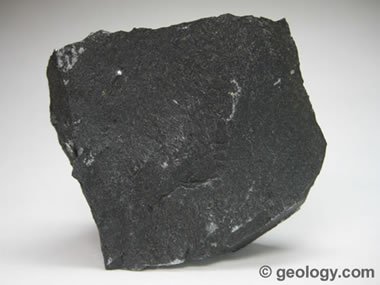
Basalt: A fine-grained igneous rock that is usually black in color. The specimen shown is about two inches (five centimeters) across.
What is Basalt?
Basalt is a dark-colored, fine-grained, igneous rock composed mainly of plagioclase and pyroxene minerals. It most commonly forms as an extrusive rock, such as a lava flow, but can also form in small intrusive bodies, such as an igneous dike or a thin sill. It has a composition similar to gabbro. The difference between basalt and gabbro is that basalt is a fine-grained rock while gabbro is a coarse-grained rock.
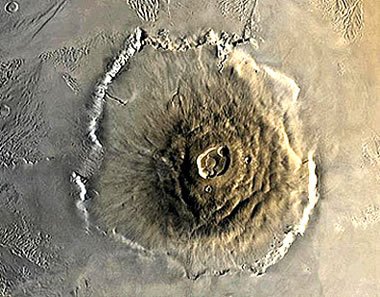
Olympus Mons Volcano: This shield volcano is composed of basalt and has enormous calderas at the summit. Olympus Mons is the highest topographic feature on Mars and is the largest known volcano in our solar system. It is about 375 miles (600 kilometers) in diameter and 15 miles (25 kilometers) high. NASA Mars Orbiter Camera image.
Earth's Most Abundant Bedrock
Basalt underlies more of Earth's surface than any other rock type. Most areas within Earth's ocean basins are underlain by basalt. Although basalt is much less common on continents, lava flows and flood basalts underlie several percent of Earth's land surface. Basalt is a very important rock.
Basalt on Moon and Mars
Basalt is also an abundant rock on the Moon. Much of the Moon's surface is underlain by basaltic lava flows and flood basalts. These areas of the Moon are known as "lunar maria." Large areas of the Moon have been resurfaced by extensive basalt flows which may have been triggered by major impact events. The ages of lunar maria can be estimated by observing the density of impact craters on their surface. Younger basalt flows will have fewer craters.
Olympus Mons is a shield volcano on Mars. It, like most other volcanic features on Mars, was formed from basaltic lava flows. It is the highest mountain on Mars and is the largest known volcano in our solar system.
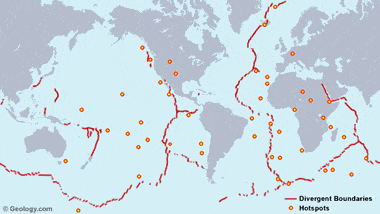
Basalt-Forming Environments: This map shows the location of oceanic divergent boundaries and hotspots. These are locations where large volumes of basalt have been formed. Map copyright by Geology.com and MapResources. Locations generalized after United States Geological Survey, Geologic Investigations Map I-2800: This Dynamic Planet.
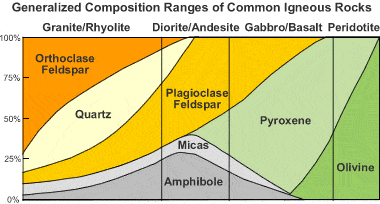
Igneous rock composition chart: This chart shows that basalt is typically composed of pyroxenes, plagioclase, micas, and amphiboles.
Basalt-Forming Environments
Most of the basalt found on Earth was produced in just three rock-forming environments: 1) oceanic divergent boundaries, 2) oceanic hotspots, and 3) mantle plumes and hotspots beneath continents. The images on this page feature some of these basalt-forming environments.
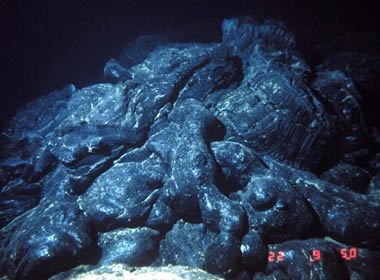
Sea floor pillow basalts on the Juan de Fuca Ridge, a divergent plate boundary located about 150 miles (240 kilometers) west of the Washington-Oregon coast. This lava flow, produced by a fissure eruption, was about five years old when the photograph was taken. NOAA Ocean Explorer image.
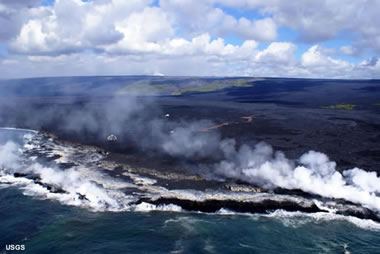
Hawaii Basalt Flows: Lava flows dump into the Pacific Ocean on the coast of Hawaii. Multiple locations where hot lava streams into the ocean can be seen in this image along with a red-hot lava flow traversing the lava field. This photo shows the enormous extent of the flows. They extend from the shoreline up to the horizon. A volcanic plume from the Pu'u'ō'ō vent can be seen over the horizon near the center of the image. The lava in these flows originated from the Pu'u'ō'ō vent. USGS image.
Basalts at Oceanic Divergent Boundaries
Most of Earth's basalt is produced at divergent plate boundaries on the mid-ocean ridge system (see map). Here convection currents deliver hot rock from deep in the mantle. This hot rock melts as the divergent boundary pulls apart, and the molten rock erupts onto the sea floor. These submarine fissure eruptions often produce pillow basalts as shown in the image on this page.
The active mid-ocean ridges host repeated fissure eruptions. Most of this activity is unnoticed because these boundaries are under great depths of water. At these deep locations, any steam, ash, or gas produced is absorbed by the water column and does not reach the surface. Earthquake activity is the only signal to humans that many of these deep ocean ridge eruptions provide. However, Iceland is a location where a mid-ocean ridge has been lifted above sea level. There, people can directly observe this volcanic activity.
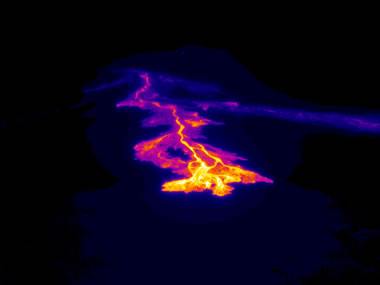
Thermal image of a hot basalt flow on the flank of Hawaii's Kilauea volcano. Hot lava at the front of the flow is revealed in yellow, orange and red colors. The channel that it flowed through on the previous day appears as a purple and blue track. United States Geological Survey image.
Oceanic Hotspots
Another location where significant amounts of basalt are produced is above oceanic hotspots. These are locations (see map above) where a small plume of hot rock rises up through the mantle from a hotspot on Earth's core. The Hawaiian Islands are an example of where basaltic volcanoes have been built above an oceanic hotspot.
Basalt production at these locations begins with an eruption on the ocean floor. If the hotspot is sustained, repeated eruptions can build the volcanic cone larger and larger until it becomes high enough to become an island. All of the islands in the Hawaiian Island chain were built up from basalt eruptions on the sea floor.
The island that we know today as "Hawaii" is thought to be between 300,000 and 600,000 years old. It began as an eruption on the floor of the Pacific Ocean. The volcanic cone grew as recurrent eruptions built up layer after layer of basalt flows. About 100,000 years ago it is thought to have grown tall enough to emerge from the ocean as an island.
Today it consists of five overlapping volcanoes. Kilauea is the most active of these volcanoes. It has been in amost continuous eruption since January, 1983. Basalt flows from Kilauea have extruded over one cubic mile of lava, which currently covers about 48 square miles of land. These flows have travelled over seven miles to reach the ocean, covering highways, homes and entire subdivisions that were in their path.
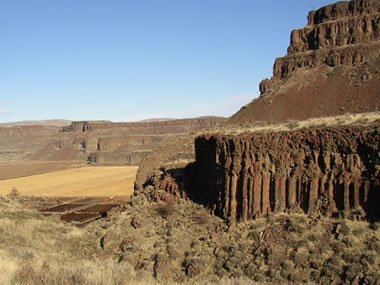
Columbia River Flood Basalts: The Columbia River Flood Basalts are an extensive sequence of stacked lava flows that reach a cumulative thickness of up to 6000 feet. The outcrops in the foreground and in the distance of this photo are all made up of layered basalt flows. Although basalt is typically a dark black rock, it often weathers to a yellow-brown color similar to the rocks shown here. Public domain image by Williamborg.
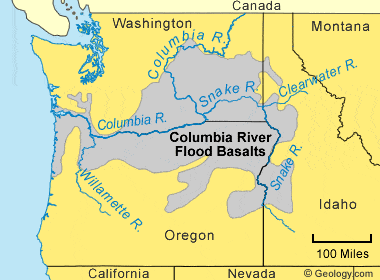
Columbia River Flood Basalts Map: A map of the area underlain by the Columbia River Flood Basalts in Washington, Oregon, and Idaho. The area shown is what has not yet been eroded away - the original extent of these basalt flows was much greater. Over 300 individual flows have been identified, and several hundred meters of basalt underlies much of the area shown in the map above. Map copyright by Geology.com and MapResources.com.
Plumes & Hotspots Below Continents
The third basalt-forming environment is a continental environment where a mantle plume or hotspot delivers enormous amounts of basaltic lava through the continental crust and up to Earth's surface. These eruptions can be from either vents or fissures. They have produced the largest basalt flows on the continents. The eruptions can occur repeatedly over millions of years, producing layer after layer of basalt stacked in a vertical sequence (see outcrop photo).
The Columbia River Flood Basalts in Washington, Oregon, and Idaho are an example of extensive flood basalts on land (see map below). Other examples include the Emeishan Traps of China, the Deccan Traps of India, the Keweenawan Lavas of the Lake Superior region, the Etendeka Basalts of Namibia, the Karroo Basalts of South Africa, and the Siberian Traps of Russia. (The word "traps" is derived from the Swedish word for "stairs," which describes the outcrop profile of these layered basalt deposits, as shown in the outcrop photo.)
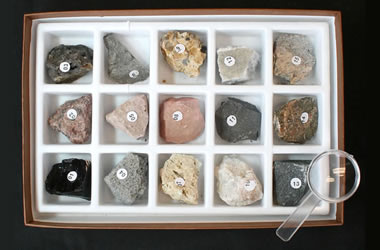
Rock & Mineral Kits: Get a rock, mineral, or fossil kit to learn more about Earth materials. The best way to learn about rocks is to have specimens available for testing and examination.
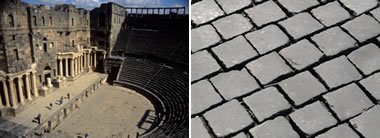
The Roman theatre: (left) in Bosra, Syria. The dark building stone is basalt. Image copyright iStockphoto / Steve Estvanik.
Basalt paving stones: (right) on a city street in Rome, Italy. Basalt pavers were often used in areas close to volcanoes. Image copyright iStockphoto / Giovanni Rinaldi.
Uses of Basalt
Basalt is used for a wide variety of purposes. It is most commonly crushed for use as an aggregate in construction projects. Crushed basalt is used for road base, concrete aggregate, asphalt pavement aggregate, railroad ballast, filter stone in drain fields, and may other purposes. Basalt is also cut into dimension stone. Thin slabs of basalt are cut and sometimes polished for use as floor tiles, building veneer, monuments, and other stone objects.
| More Rocks |
 |
Tumbled Stones |
 |
Fossils |
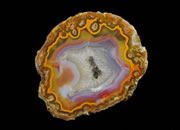 |
Geodes |
 |
The Rock Used to Make Beer |
 |
Topo Maps |
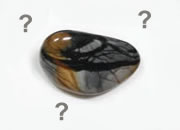 |
Difficult Rocks |
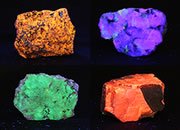 |
Fluorescent Minerals |
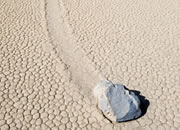 |
Sliding Rocks on Racetrack Playa |

Find Other Topics on Geology.com:

|

| ||

|

| ||

|

| ||

|

|
